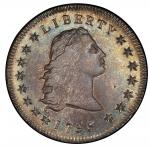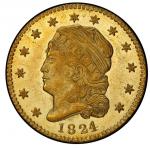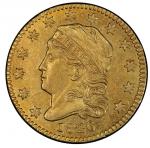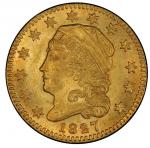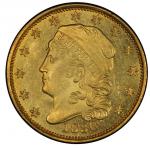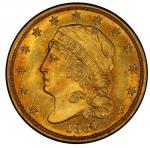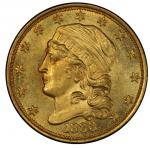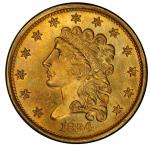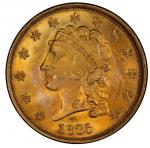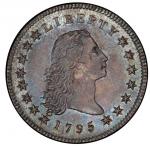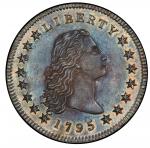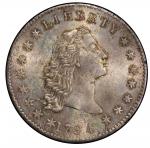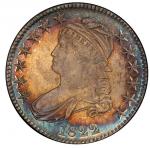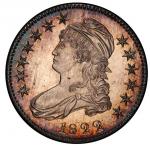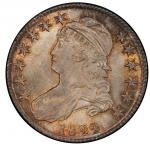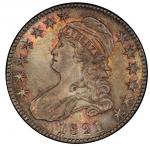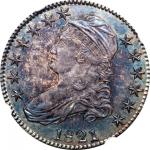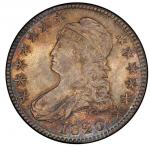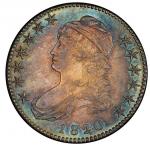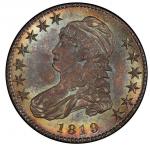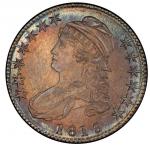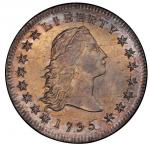The Dollar original die for the head will take six or eight days. -- Robert Scot, 1795.Spokes of cartwheel lustre swirl from rim to rim, emboldening both the rich gold of the centers and the bright brilliance inside the rims. The full reflectivity and frost of the fields emerges through the light, pleasant toning. The strike is bold on both sides, the obverse having been struck firmly enough to bring up the centers of each star along with full crisp denticles and Libertys nicely rounded cheek. Her hair is intact and well delineated, free of adjustment marks that often manifest near the obverse center. A few very subtle adjustment marks are seen at the absolute center of the reverse, where the eagles breast shows some localized softness, but the rest of that side magnificently illustrates the design as it was intended. Some vestiges of adjustment above STA of STATES blend into the background. A subtle pattern of flecks are noted across the obverse, the manifestation of tiny impurities in the silver; the longest of these horizontal flecks and striations are at absolute center, below Libertys ear, and in the upper right obverse field inside of star 9. A thin scratch arcs from the rim above star 8 to the rim above the space between LI of LIBERTY. Few marks are seen on this prime survivor that showcases the finest aspects any 18th century United States silver coin could hope to exhibit.Robert Scot was appointed engraver at the United States Mint in November 1793 and was employed in that position until his death in 1823. Scot was responsible for engraving master dies, which he called "original dies," and the central device punches or hubs that were raised from them. He also had a hand in producing the working dies that were used for coining, though some of that work was delegated to assistants like John Smith Gardner. Though modern writers have attributed several designs of this era to Gardner, he likely accomplished the day-to-day grunt work in the engraving department, executing a wide range of working dies, called "coining dies" by Scot, rather than performing the creative work that has been credited to him.Scots written testimony to Congress, offered early in 1795 to answer questions about the workload of the engraving department, has been cited by authors including Don Taxay and Robert Hilt, though Bill Nyberg was the first to actually publish it (John Reich Journal, August 2012). Scots testimony reveals that the time to engrave an obverse master die for a 1795 dollar, consisting of the Liberty head design, took "six or eight days" and a reverse master die took "nearly the same time." "After their Hubbs are compleated," Scot wrote, "a head Die for striking money may be finished in two days," assuming that the brittle steel of the die did not crack during the hardening process.The master dies created hubs, which were then used to produce working dies. Reverses required two master dies, with the eagle device on one hub or punch, the wreath on another. Today, 1795 dollars are neatly divided into two groups based upon which wreath hub was used, one showing two leaves under each wing, the other showing three leaves. Two different eagle hubs were used as well. This variety shows the same eagle and wreath used on the 1794 dollars, produced using hubs first made for the 1794 coinage. This may be among the reasons M.H. Bolender called this variety Bolender-1, though the emission sequence for 1795 dollars has never been entirely settled.Apparently hidden away during the 20th century, this specimen does not appear among the "Notable Specimens" listed in Q. David Bowers 1993 work on early dollars. Among those offered in modern times, only the MS-65 (NGC) Jack Lee-Madison Collection-Joseph C. Thomas specimen comes close to this quality. In 1890, David Proskey described this "Naked bust" dollar as a "strong, sharp and beautiful uncirculated specimen." It brought $16.75. Only two coins of the entire Two Leaves type have been certified at the MS-65 level by PCGS, this coin and the one in the next lot. Of the five 1795 dollars of all types certified MS-65 or finer by PCGS, four appear in the current sale.


